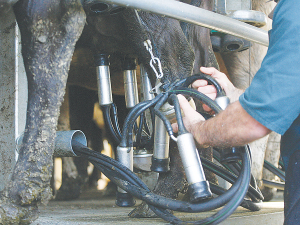Glut in global milk supply keeping prices down
The final Global Dairy Trade (GDT) auction has delivered bad news for dairy farmers.
 Last week’s Global Dairy Trade (GDT) auction saw prices drop 2.8%, with the key whole milk powder (WMP) prices falling 4.2%.
Last week’s Global Dairy Trade (GDT) auction saw prices drop 2.8%, with the key whole milk powder (WMP) prices falling 4.2%.
Dairy prices are easing but cost inflation is down across the board, providing some relief to farmers.
Last week's Global Dairy Trade (GDT) auction saw prices drop 2.8% and the key whole milk powder (WMP) prices fell 4.2%. Most products posted price falls - the exception being anhydrous milk fat which rose 2.5%. The auction was notably weaker than pre-auction expectations and futures market trends.
Westpac chief economist Kelly Eckhold notes that support from the three main regions that usually pick up the bulk of product in the auctions was weaker this time.
"Chinese buyers pulled back further as did Middle Eastern buyers a touch. In contrast to the weaker auctions last year, this time we saw regions that don't usually feature in the top three purchasers have to pick up the slack in the auction - which presumably contributed to the weak result."
However, he says Chinese demand remains around the 10-year average.
Overall, dairy prices remain around long-term averages, but on-farm costs have increased significantly over this time.
But Eckhold says latest data shows cost increases on-farm normalised in 2023 and came in close to their forecasts at an average of 2.4% over 2023.
He points out that cost inflation fell almost across the board. The only main area where costs inflation increased in 2023 compared to 2022 was with respect to central government and local authority rates and fees.
"These high and sticky cost increases have also been felt outside the farming sector. Significant declines in costs were seen in fertiliser, feed and fuel which was in large part due to the easing in supply-chain pressures seen globally now that Covid and the impact of the Russian war in Ukraine are a bit further behind us."
However, debt servicing costs remain elevated and are expected to remain high over 2024 as the RBNZ brings inflation under control.
Eckhold believes a saving grace is that interest rates currently look to have peaked. Wages costs are expected to moderate from the very high levels seen in recent years as the labour market continues to ease.
"The outlook for on-farm costs is relatively flat from here. As most cost categories have now normalised, we now see on-farm inflation trending close to aggregate economy inflation rates in the coming couple of years. That means on-farm cost inflation at around 3% in 2024 and 1.9% in 2025," he says.
Dairy prices have jumped in the overnight Global Dairy Trade (GDT) auction, breaking a five-month negative streak.
Alliance Group chief executive Willie Wiese is leaving the company after three years in the role.
A booklet produced in 2025 by the Rotoiti 15 trust, Department of Conservation and Scion – now part of the Bioeconomy Science Institute – aims to help people identify insect pests and diseases.
A Taranaki farmer and livestock agent who illegally swapped NAIT tags from cows infected with a bovine disease in an attempt to sell the cows has been fined $15,000.
Bill and Michelle Burgess had an eye-opening realisation when they produced the same with fewer cows.
It was love that first led Leah Prankerd to dairying. Decades later, it's her passion for the industry keeping her there, supporting, and inspiring farmers across the region.

OPINION: The release of the Natural Environment Bill and Planning Bill to replace the Resource Management Act is a red-letter day…
OPINION: Federated Farmers has launched a new campaign, swapping ‘The Twelve Days of Christmas’ for ‘The Twelve Pests of Christmas’ to…